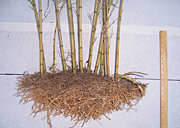- Number 308 |
- March 29, 2010
SRNL assesses bamboo for closure caps

SRNL bamboo
The very traits that can make some bamboos troublesome for landowners—quick to grow and hard to kill—make it potentially useful for cleanup, according to the Savannah River National Laboratory.
“We are looking at numerous kinds of vegetation to plant on waste site closure caps,” said Dr. Eric Nelson of SRNL. “The vegetation is there to prevent erosion and extract water from the cap. Vegetation on a cap has to be quick-growing, shallow-rooted so as not to penetrate the cap’s layers, densely rooted, cold hardy, drought tolerant, and able to thrive in full sun. It also needs to be good at preventing invasion of other plants, especially pines. We thought bamboos would have good potential.”
SRNL selected two of the smaller species, with runners, for assessment. In 1991, they were planted in a one-acre plot about ten feet apart, and then ignored. Dr. Nelson assessed the nursery 14 years later.
“The bamboo grew in well and there were relatively few other plants that invaded the plots. The bamboo was especially effective in keeping out pines,” he said. “We did another assessment late last year with similar results. Bamboo, especially P. bissetii, is a good candidate for use on a closure cap.”
Dr. Nelson said that much further research is needed. “Soils are important; moisture balance and nutrient cycles are also important. We also need to understand more fully the early growth and establishment of the bamboo and its performance in closure cap conditions. This nursery has helped us define future research needs and operational issues.”[Eric Nelson, 803/725-5212,
eric.nelson@srnl.doe.gov]
